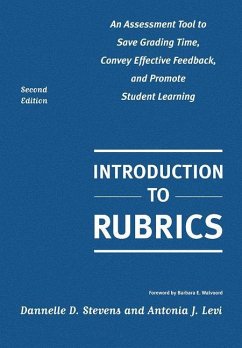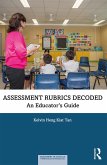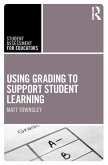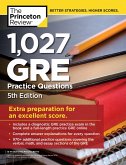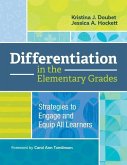Dannelle D. Stevens, Antonia J. Levi
Introduction to Rubrics
An Assessment Tool to Save Grading Time, Convey Effective Feedback, and Promote Student Learning
Dannelle D. Stevens, Antonia J. Levi
Introduction to Rubrics
An Assessment Tool to Save Grading Time, Convey Effective Feedback, and Promote Student Learning
- Gebundenes Buch
- Merkliste
- Auf die Merkliste
- Bewerten Bewerten
- Teilen
- Produkt teilen
- Produkterinnerung
- Produkterinnerung
This new edition retains the appeal, clarity and practicality that made the first so successful, and continues to provide a fundamental introduction to the principles and purposes of rubrics, with guidance on how to construct them, use them to align course content to learning outcomes, and apply them in a wide variety of courses, and to all forms of assignment.
Andere Kunden interessierten sich auch für
![A Comprehensive Critique of Student Evaluation of Teaching A Comprehensive Critique of Student Evaluation of Teaching]() Dennis E. Clayson (US. University of Northern Iowa)A Comprehensive Critique of Student Evaluation of Teaching27,99 €
Dennis E. Clayson (US. University of Northern Iowa)A Comprehensive Critique of Student Evaluation of Teaching27,99 €![Learning in the Fast Lane Learning in the Fast Lane]() Finn, Chester E., Jr.Learning in the Fast Lane23,99 €
Finn, Chester E., Jr.Learning in the Fast Lane23,99 €![Assessment Rubrics Decoded Assessment Rubrics Decoded]() Kelvin Heng Kiat Tan (Singapore National Institute of Education)Assessment Rubrics Decoded46,99 €
Kelvin Heng Kiat Tan (Singapore National Institute of Education)Assessment Rubrics Decoded46,99 €![Using Grading to Support Student Learning Using Grading to Support Student Learning]() Matt TownsleyUsing Grading to Support Student Learning28,99 €
Matt TownsleyUsing Grading to Support Student Learning28,99 €![1,027 GRE Practice Questions, 5th Edition: GRE Prep for an Excellent Score 1,027 GRE Practice Questions, 5th Edition: GRE Prep for an Excellent Score]() Princeton Review1,027 GRE Practice Questions, 5th Edition: GRE Prep for an Excellent Score19,99 €
Princeton Review1,027 GRE Practice Questions, 5th Edition: GRE Prep for an Excellent Score19,99 €![Assessment, Bureaucracy, and Consolidation Assessment, Bureaucracy, and Consolidation]() Donald ParkersonAssessment, Bureaucracy, and Consolidation91,99 €
Donald ParkersonAssessment, Bureaucracy, and Consolidation91,99 €![Differentiation in the Elementary Grades: Strategies to Engage and Equip All Learners Differentiation in the Elementary Grades: Strategies to Engage and Equip All Learners]() Kristina J. DoubetDifferentiation in the Elementary Grades: Strategies to Engage and Equip All Learners35,99 €
Kristina J. DoubetDifferentiation in the Elementary Grades: Strategies to Engage and Equip All Learners35,99 €-
-
-
This new edition retains the appeal, clarity and practicality that made the first so successful, and continues to provide a fundamental introduction to the principles and purposes of rubrics, with guidance on how to construct them, use them to align course content to learning outcomes, and apply them in a wide variety of courses, and to all forms of assignment.
Produktdetails
- Produktdetails
- Verlag: Stylus Publishing
- Second Edition
- Seitenzahl: 238
- Erscheinungstermin: 8. Oktober 2012
- Englisch
- Abmessung: 254mm x 175mm x 20mm
- Gewicht: 600g
- ISBN-13: 9781579225872
- ISBN-10: 157922587X
- Artikelnr.: 32874454
- Verlag: Stylus Publishing
- Second Edition
- Seitenzahl: 238
- Erscheinungstermin: 8. Oktober 2012
- Englisch
- Abmessung: 254mm x 175mm x 20mm
- Gewicht: 600g
- ISBN-13: 9781579225872
- ISBN-10: 157922587X
- Artikelnr.: 32874454
Dannelle D. Stevens is a tenured professor in the Department of Curriculum and Instruction at Portland State University in Oregon where she has been since 1994. Her roots, however, are in the public school classroom where she taught middle school and high school social studies, language arts, and special education for 14 years across four school districts and three states. She received her master's from the University of Utah in 1983, and a doctorate in educational psychology from Michigan State in 1991. Before coming to PSU she taught at Whitman College in Walla Walla, Washington. Whether the topic is rubrics, journal writing, action research or academic writing, her work centers on how adults reflect on what they do and, then, act on those reflections. One of Dr. Stevens' underlying assumptions is that cognitive, social and emotional development does not end with the teenage years but continues through the lifetime. Besides over 75 conference presentations, she has written three books, all designed to impact development of her fellow faculty and their students. Her first book, co-edited with Joanne Cooper, Tenure in the Sacred Grove: Issues and Strategies for Women and Minorities, (SUNY Press, 2002), was written to help faculty women and minorities negotiate the path to tenure. Introduction to Rubrics, now in its second edition, and co-authored with Antonia J. Levi, and Journal Keeping, co-authored with Joanne Cooper, are both published by Stylus Publishing. In addition to teaching classes, she has taken on leadership positions in the department and campus-wide. In the Curriculum and Instruction Department, Dr. Stevens leads teacher licensure cohorts and coordinates the MA/MS program for experienced teachers. For the university at large, she works within the Center for Academic Excellence as faculty-in-residence for assessment. She is chair of the Institutional Assessment Council. Antonia J. Levi is a professor of Japanese history and popular culture who taught for many years in Portland (Oregon) State University's University Studies Program, an innovative common core experience for Freshmen that created and utilizes many of the methodologies found in Introduction to Rubrics. Now retired, she serves part-time as a mentor and curriculum developer in Simon Fraser University's South Bank Writer's Program in British Columbia (Canada) where she is working on expanding the use of rubrics for creative writers. She has over thirty years of active classroom experience, and has worked on numerous projects from creating portfolios for seamless transitions to increasing opportunities for overseas studies programs. Her experience with rubrics in the classroom has contributed to these programs as well. Barbara E. Walvoord is a Professor Emerita at the University of Notre Dame, Indiana. She is the author of numerous books, including Effective Grading: A Tool for Learning and Assessment with V. J. Anderson, and Assessment Clear and Simple: A Practical Guide for Institutions, Departments, and General Education
LIST OF FIGURES FOREWORD Barbara E. Walvoord PREFACE TO THE SECOND EDITION
PREFACE TO THE FIRST EDITION PART I. AN INTRODUCTION TO RUBRICS 1. WHAT IS
A RUBRIC? 2. WHY USE RUBRICS? 3. HOW TO CONSTRUCT A RUBRIC PART II. RUBRIC
CONSTRUCTION AND USE IN DIFFERENT CONTEXTS 4. RUBRIC CONSTRUCTION AND THE
CLASSROOM 5. RUBRIC CONSTRUCTION WITH OTHERS. TEACHING ASSISTANTS, TUTORS,
OR COLLEAGUES 6. GRADING WITH RUBRICS 7. MAKING IT YOURS 8. RUBRICS FOR
LEARNING FROM EXPERIENCE 9. RUBRICS AND ONLINE LEARNING 10. RUBRICS AND
TEACHING IMPROVEMENT 11. RUBRICS FOR SELF-ASSESSMENT AND CAREER ADVANCEMENT
12. RUBRICS AND PROGRAM ASSESSMENT EPILOGUE. THE RUBRICS MANIFESTO
REFERENCES APPENDICES INDEX
PREFACE TO THE FIRST EDITION PART I. AN INTRODUCTION TO RUBRICS 1. WHAT IS
A RUBRIC? 2. WHY USE RUBRICS? 3. HOW TO CONSTRUCT A RUBRIC PART II. RUBRIC
CONSTRUCTION AND USE IN DIFFERENT CONTEXTS 4. RUBRIC CONSTRUCTION AND THE
CLASSROOM 5. RUBRIC CONSTRUCTION WITH OTHERS. TEACHING ASSISTANTS, TUTORS,
OR COLLEAGUES 6. GRADING WITH RUBRICS 7. MAKING IT YOURS 8. RUBRICS FOR
LEARNING FROM EXPERIENCE 9. RUBRICS AND ONLINE LEARNING 10. RUBRICS AND
TEACHING IMPROVEMENT 11. RUBRICS FOR SELF-ASSESSMENT AND CAREER ADVANCEMENT
12. RUBRICS AND PROGRAM ASSESSMENT EPILOGUE. THE RUBRICS MANIFESTO
REFERENCES APPENDICES INDEX
LIST OF FIGURES FOREWORD Barbara E. Walvoord PREFACE TO THE SECOND EDITION
PREFACE TO THE FIRST EDITION PART I. AN INTRODUCTION TO RUBRICS 1. WHAT IS
A RUBRIC? 2. WHY USE RUBRICS? 3. HOW TO CONSTRUCT A RUBRIC PART II. RUBRIC
CONSTRUCTION AND USE IN DIFFERENT CONTEXTS 4. RUBRIC CONSTRUCTION AND THE
CLASSROOM 5. RUBRIC CONSTRUCTION WITH OTHERS. TEACHING ASSISTANTS, TUTORS,
OR COLLEAGUES 6. GRADING WITH RUBRICS 7. MAKING IT YOURS 8. RUBRICS FOR
LEARNING FROM EXPERIENCE 9. RUBRICS AND ONLINE LEARNING 10. RUBRICS AND
TEACHING IMPROVEMENT 11. RUBRICS FOR SELF-ASSESSMENT AND CAREER ADVANCEMENT
12. RUBRICS AND PROGRAM ASSESSMENT EPILOGUE. THE RUBRICS MANIFESTO
REFERENCES APPENDICES INDEX
PREFACE TO THE FIRST EDITION PART I. AN INTRODUCTION TO RUBRICS 1. WHAT IS
A RUBRIC? 2. WHY USE RUBRICS? 3. HOW TO CONSTRUCT A RUBRIC PART II. RUBRIC
CONSTRUCTION AND USE IN DIFFERENT CONTEXTS 4. RUBRIC CONSTRUCTION AND THE
CLASSROOM 5. RUBRIC CONSTRUCTION WITH OTHERS. TEACHING ASSISTANTS, TUTORS,
OR COLLEAGUES 6. GRADING WITH RUBRICS 7. MAKING IT YOURS 8. RUBRICS FOR
LEARNING FROM EXPERIENCE 9. RUBRICS AND ONLINE LEARNING 10. RUBRICS AND
TEACHING IMPROVEMENT 11. RUBRICS FOR SELF-ASSESSMENT AND CAREER ADVANCEMENT
12. RUBRICS AND PROGRAM ASSESSMENT EPILOGUE. THE RUBRICS MANIFESTO
REFERENCES APPENDICES INDEX

